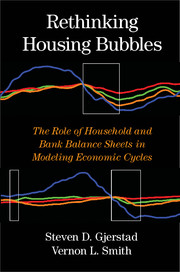 Rethinking Housing Bubbles
Rethinking Housing Bubbles Book contents
- Frontmatter
- Contents
- Acknowledgments
- 1 Economic Crises, Economic Policy, and Economic Analysis
- 2 Goods and Services Markets versus Asset Markets
- 3 Asset Performance
- 4 The Great Depression
- 5 The Postwar Recessions
- 6 What May Have Triggered or Sustained the Housing Bubble (1997–2006)?
- 7 The Bubble Bursts
- 8 Blindsided Experts
- 9 What Might Be Done?
- 10 Learning from Foreign Economic Crises
- 11 Summary: What Have We Learned?
- Index
- References
5 - The Postwar Recessions
Published online by Cambridge University Press: 05 June 2014
- Frontmatter
- Contents
- Acknowledgments
- 1 Economic Crises, Economic Policy, and Economic Analysis
- 2 Goods and Services Markets versus Asset Markets
- 3 Asset Performance
- 4 The Great Depression
- 5 The Postwar Recessions
- 6 What May Have Triggered or Sustained the Housing Bubble (1997–2006)?
- 7 The Bubble Bursts
- 8 Blindsided Experts
- 9 What Might Be Done?
- 10 Learning from Foreign Economic Crises
- 11 Summary: What Have We Learned?
- Index
- References
Summary
“[T]he investment component of output is about six times as volatile as the consumption component.”
– Edward C. Prescott (1986a)“[T]echnology shocks account for more than half the fluctuations in the postwar period, with a best point estimate near 75 percent.”
– Edward C. Prescott (1986b)“[R]esidential investment causes, but is not caused by GDP [movements], while non-residential investment does not cause, but is caused by GDP [movements].”
– Richard K. Green (1997)In this chapter, we examine the ten postwar recessions from 1948–9 to 2001 that preceded the Great Recession. The role of housing investment expenditures in both the Great Recession and the Depression is also manifest in the post–World War II period but with less catastrophic consequences. Recurrent patterns of interaction between housing investment and monetary policy are prominent elements of postwar U.S. economic cycles. Examination of these interactions clarifies one of the primary channels through which monetary policy affects output, especially in the period immediately preceding a recession, during the recession, and in the immediate aftermath of a recession.
- Type
- Chapter
- Information
- Rethinking Housing BubblesThe Role of Household and Bank Balance Sheets in Modeling Economic Cycles, pp. 122 - 145Publisher: Cambridge University PressPrint publication year: 2014


